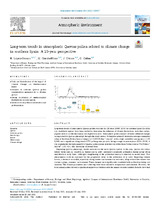Long-term trends in atmospheric Quercus pollen related to climate change in southern Spain: A 25-year perspective
Autor
López Orozco, Rocío
García-Mozo, H.
Oteros, José
Galán, Carmen
Editor
MDPIFecha
2021Materia
QuercusAirborne pollen
Aerobiology
Trends
Meteorology
Climate change
METS:
Mostrar el registro METSPREMIS:
Mostrar el registro PREMISMetadatos
Mostrar el registro completo del ítemResumen
Long-term trends of atmospheric Quercus pollen recorded for 25 years (1995–2019) in southern Spain (Cordoba city, Andalusia region) have been studied to determine the influence of climate fluctuations and other anthropogenic factors on Mediterranean oak vegetation areas. Atmospheric pollen analysis revealed different changes on reproductive Quercus phenology through the study period. Pollination intensity showed an average cumulated value of the Main Pollen Season Integral of 12,832 Pollen * day/m3, with a high variability among years (±SD 8,048) and a significant rising trend of 771 pollen grains per year, being stronger in recent years (2014–2019). It was remarkable the high quantity of Quercus pollen grains detected out of the Main Pollen Season (703 Pollen * day/m3 ± SD 431), also increasing in recent years. Regarding Quercus phenology, results indicated as the main Quercus species in the area, Quercus ilex subsp. ballota (holm oak), Q. coccifera, Q. faginea and Q. suber, presented a gradually pollination during spring (from mid-March to early June), although a lengthening of the pollination season is observed in recent years. This phenomenon could be explained by the progressive delay in the pollination of Q. suber. Regarding climate factors, a decrease in rainfall, especially during winter and autumn was recorded, along with colder winters but warmer springs, summers, and autumns. These changes were significantly correlated with pollination timing and intensity. The climate parameters most affecting were those related to temperature and sunshine. However, the total annual pollen showed a significant negative correlation with the annual recorded rainfall. Results show that recent climatic change, among other factors, are leading to changes in the timing and intensity of the Quercus pollen season in the Mediterranean area.

